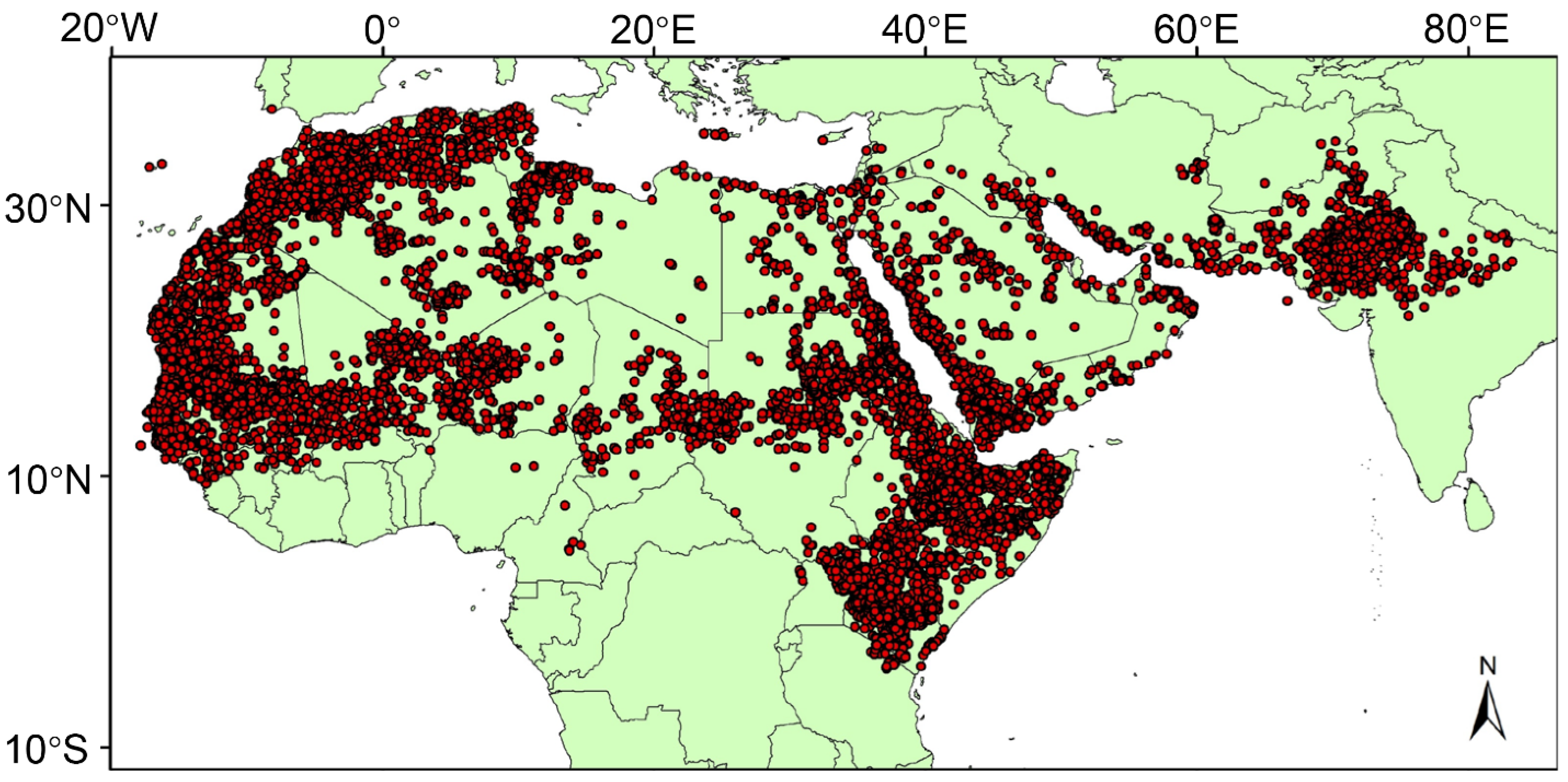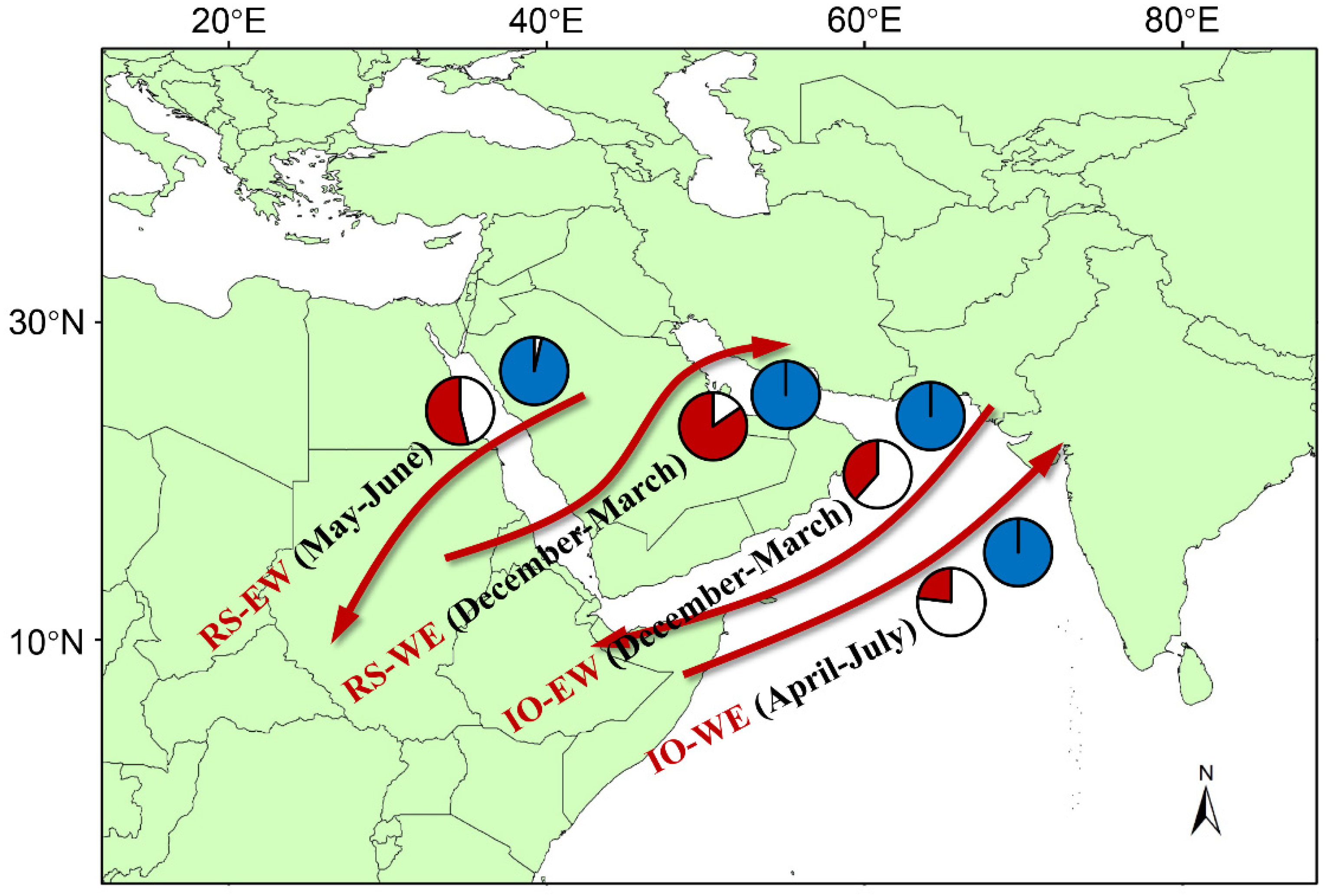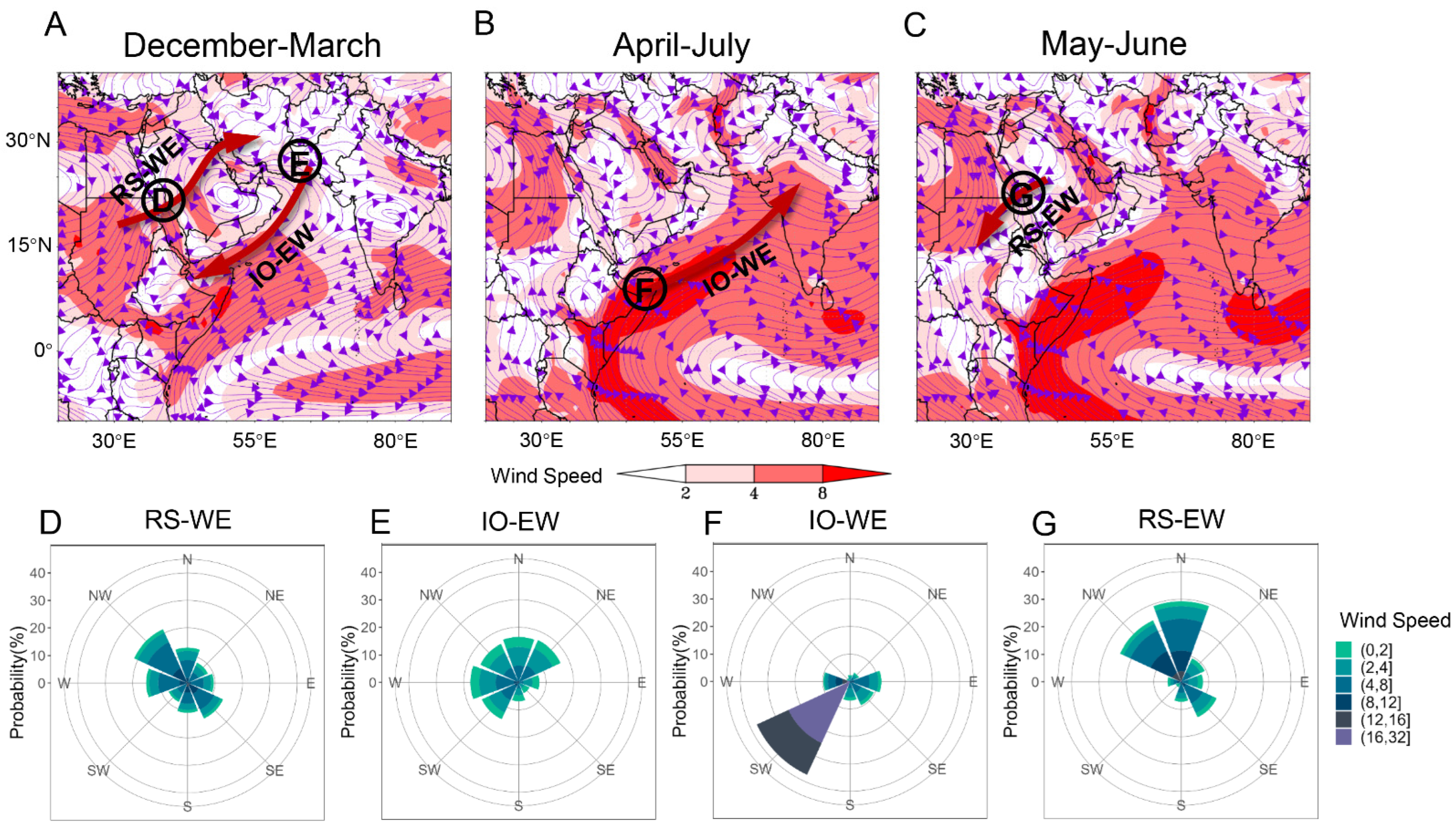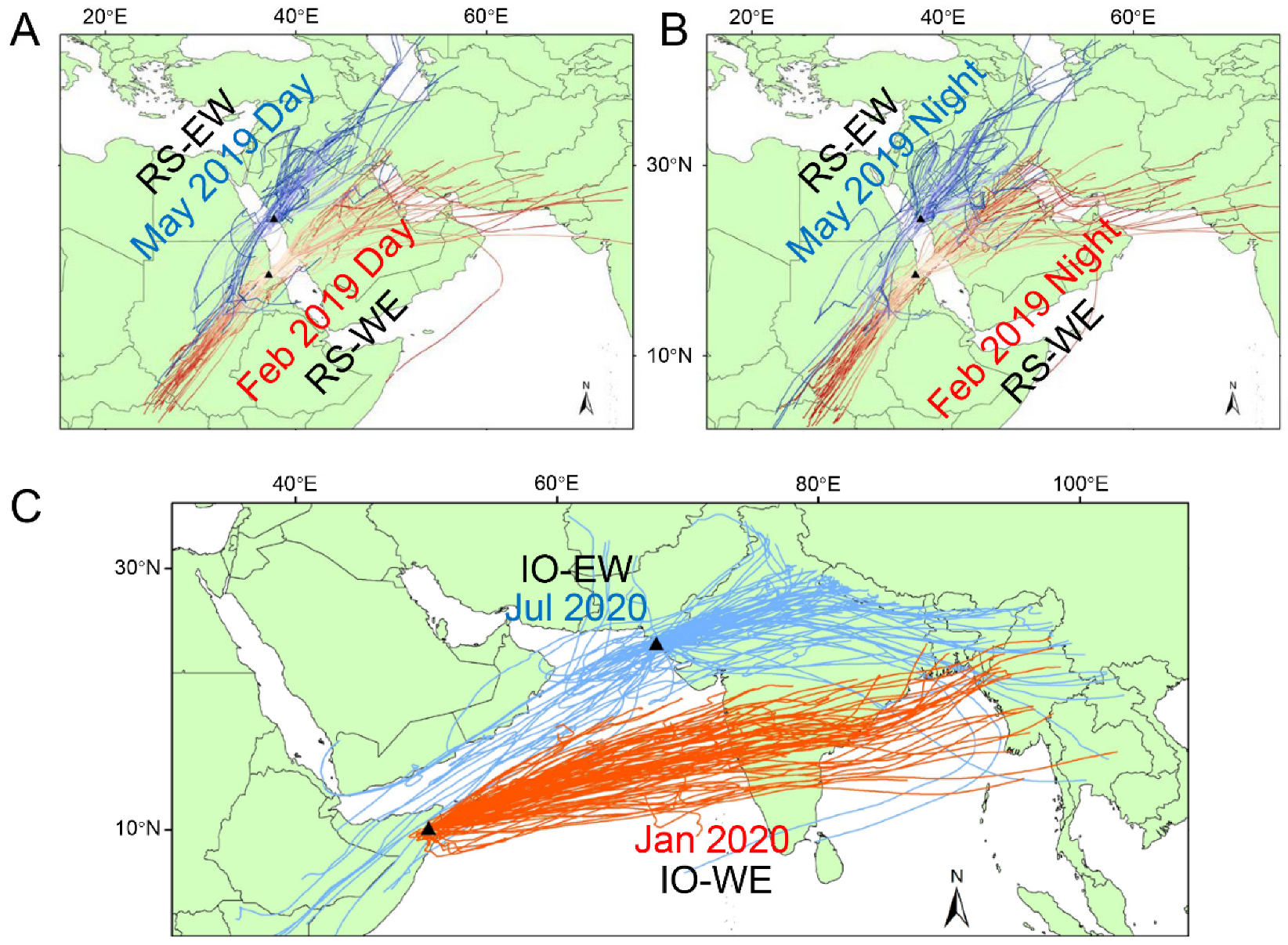Intercontinental Migration Facilitates Continuous Occurrence of the Desert Locust Schistocerca gregaria (Forsk., 1775) in Africa and Asia
Abstract
:1. Introduction
2. Materials and Methods
2.1. Desert Locust Migration Routes Inference
2.2. Wind Field Analyses
2.3. Windborne Migration at High-Altitude
3. Results
3.1. Historical Monitoring Data Supports 4 Intercontinental Migration Routes of the Desert Locust
3.2. Long-Term Wind Field Data Support the Four Migration Routes
3.3. Modelling Windborne Migration along the 4 Routes
4. Discussion
5. Conclusions
Supplementary Materials
Author Contributions
Funding
Data Availability Statement
Conflicts of Interest
References
- Peng, W.; Ma, N.L.; Zhang, D.; Zhou, Q.; Yue, X.; Khoo, S.C.; Yang, H.; Guan, R.; Chen, H.; Zhang, X.; et al. A review of historical and recent locust outbreaks: Links to global warming, food security and mitigation strategies. Environ. Res. 2020, 191, 110046. [Google Scholar] [CrossRef] [PubMed]
- Klein, I.; Oppelt, N.; Kuenzer, C. Application of Remote Sensing Data for Locust Research and Management—A Review. Insects 2021, 12, 233. [Google Scholar] [CrossRef]
- Sánchez-Zapata, J.A.; Donázar, J.A.; Delgado, A.; Forero, M.G.; Ceballos, O.; Hiraldo, F. Desert locust outbreaks in the Sahel: Resource competition, predation and ecological effects of pest control. J. Appl. Ecol. 2007, 44, 323–329. [Google Scholar] [CrossRef]
- Katel, S.; Mandal, H.R.; Neupane, P.; Timsina, S.; Pokhrel, P.; Katuwal, A.; Subedi, S.; Shrestha, J.; Shah, K.K. Desert locust (Schistocerca gregaria Forskal) and its management: A review. J. Agric. Appl. Biol. 2021, 2, 61–69. [Google Scholar] [CrossRef]
- Renier, C.; Waldner, F.; Jacques, D.C.; Babah Ebbe, M.A.; Cressman, K.; Defourny, P. A Dynamic Vegetation Senescence Indicator for Near-Real-Time Desert Locust Habitat Monitoring with MODIS. Remote Sens. 2015, 7, 7545–7570. [Google Scholar] [CrossRef]
- Showler, A.T. Desert Locust Control: The Effectiveness of Proactive Interventions and the Goal of Outbreak Prevention. Am. Entomol. 2019, 65, 180–191. [Google Scholar] [CrossRef]
- Jhiknaria, H. Distribution of Desert Locust Schistocerca gregaria in Rajasthan, India and Establishing an Early Warning System for Locust Control in India. 2021. Available online: https://www.researchsquare.com/article/rs-558472/latest (accessed on 10 April 2024).
- Barasa, B.; Watsusi, C.W.; Gudoyi, P.M.; Lutaaya, N.; Gumisiriza, L.T.; Magaya, J.P. Desert Locust Invasion in Uganda: Effects on Household Food Consumption and Effective Control Interventions. Sustain. Sci. Pract. Policy 2023, 15, 14496. [Google Scholar] [CrossRef]
- Rosenberg, J.; Burt, P.J.A. Windborne displacements of Desert Locusts from Africa to the Caribbean and South America. Aerobiologia 1999, 15, 167–175. [Google Scholar] [CrossRef]
- Pedgley, D. Desert Locust Forecasting Manual; Natural Resources Institute: London, UK, 1981. [Google Scholar]
- Symmons, P.M.; Cressman, K. Desert Locust Guidelines: Biology and Behaviour. FAO, Rome. 2021. Available online: https://www.researchgate.net/profile/Keith-Cressman/publication/265217762_Desert_Locust_Guidelines_1_Biology_and_Behaviour/links/563b3ea808ae45b5d285c7fe/Desert-Locust-Guidelines-1-Biology-and-Behaviour.pdf (accessed on 10 April 2024).
- Wang, Y.-P.; Wu, M.-F.; Lin, P.-J.; Wang, Y.; Chen, A.-D.; Jiang, Y.-Y.; Zhai, B.-P.; Chapman, J.W.; Hu, G. Plagues of Desert Locusts: Very Low Invasion Risk to China. Insects 2020, 11, 628. [Google Scholar] [CrossRef]
- Rainey, R.C. Weather and the movements of locust swarms: A new hypothesis. Nature 1951, 168, 1057–1060. [Google Scholar] [CrossRef]
- Draper, J. The direction of desert locust migration. J. Anim. Ecol. 1980, 49, 959–974. [Google Scholar] [CrossRef]
- Sword, G.A. Gregarious Behaviour in Insects, Encyclopedia of Entomology; Springer: Dordrecht, The Netherlands, 2009. [Google Scholar]
- Homberg, U. Sky compass orientation in desert locusts-evidence from field and laboratory studies. Front. Behav. Neurosci. 2015, 9, 346. [Google Scholar] [CrossRef] [PubMed]
- Samejo, A.A.; Sultana, R.; Kumar, S.; Soomro, S. Could Entomophagy Be an Effective Mitigation Measure in Desert Locust Management? Agronomy 2021, 11, 455. [Google Scholar] [CrossRef]
- Matthews, R.W.; Matthews, J.R. Insect Behavior; Springer Science & Business Media: Berlin/Heidelberg, Germany, 2009. [Google Scholar]
- Magor, J.I.; Lecoq, M.; Hunter, D.M. Preventive control and Desert Locust plagues. Crop Prot. 2008, 27, 1527–1533. [Google Scholar] [CrossRef]
- Pedgley, D.E. Weather and the current desert locust plague. Weather 1989, 44, 168–171. [Google Scholar] [CrossRef]
- Salih, A.A.M.; Baraibar, M.; Mwangi, K.K.; Artan, G. Climate change and locust outbreak in East Africa. Nat. Clim. Change 2020, 10, 584–585. [Google Scholar] [CrossRef]
- Cressman, K. Desert locust. In Biological and Environmental Hazards, Risks, and Disasters; Elsevier: Amsterdam, The Netherlands, 2016. [Google Scholar]
- Uvarov, B.P. Locusts and Grasshoppers. A Handbook for Their Study and Control. 1928. Available online: https://www.cabdirect.org/cabdirect/abstract/19290500003 (accessed on 10 April 2024).
- Wolf, H. On the function of a locust flight steering muscle and its inhibitory innervation. J. Exp. Biol. 1990, 150, 55–80. [Google Scholar] [CrossRef]
- Chapman, J.W.; Reynolds, D.R.; Wilson, K. Long-range seasonal migration in insects: Mechanisms, evolutionary drivers and ecological consequences. Ecol. Lett. 2015, 18, 287–302. [Google Scholar] [CrossRef] [PubMed]
- Kennedy, J.S. The migration of the desert locust (Schistocerca gregaria Forsk.). I. The behaviour of swarms. II. A theory of long-range migrations. Philos. Trans. R. Soc. Lond. B Biol. Sci. 1951, 235, 163–290. [Google Scholar]
- Chapman, R.F. Observations On the Flight Activity of the Red Locust, Nomadacris septemfasciata (Serville). Behaviour 1959, 14, 300–333. [Google Scholar] [CrossRef]
- Waloff, Z. Upsurges and Recessions of the Desert Locust Plague: Historical Survey; Centre for Overseas Pest Research: London, UK, 1966. [Google Scholar]
- Gunn, D.L.; Brown, H.D. Setting the scene The development of aircraft attack on locust swarms in Africa since 1945 and the start of operational research on control systems. Philos. Trans. R. Soc. Lond. 1979, 287, 251–263. [Google Scholar]
- Wu, Q.; Hu, G.; Westbrook, J.K.; Sword, G.A.; Zhai, B. An advanced numerical trajectory model tracks a corn earworm moth migration event in Texas, USA. Insects 2018, 9, 115. [Google Scholar] [CrossRef] [PubMed]
- Liu, J.; Lecoq, M.; Zhang, L. Desert Locust Stopped by Tibetan Highlands during the 2020 Upsurge. Agronomy 2021, 11, 2287. [Google Scholar] [CrossRef]
- Meynard, C.N.; Lecoq, M.; Chapuis, M.-P.; Piou, C. On the relative role of climate change and management in the current desert locust outbreak in East Africa. Glob. Change Biol. 2020, 26, 3753–3755. [Google Scholar] [CrossRef] [PubMed]
- Guan, J.; Li, M.; Ju, X.; Lin, J.; Wu, J.; Zheng, J. The potential habitat of desert locusts is contracting: Predictions under climate change scenarios. PeerJ 2021, 9, e12311. [Google Scholar] [CrossRef] [PubMed]
- Wang, L.; Zhuo, W.; Pei, Z.; Tong, X.; Han, W.; Fang, S. Using Long-Term Earth Observation Data to Reveal the Factors Contributing to the Early 2020 Desert Locust Upsurge and the Resulting Vegetation Loss. Remote Sens. 2021, 13, 680. [Google Scholar] [CrossRef]
- Tucker, C.J.; Hielkema, J.U.; Roffey, J. The potential of satellite remote sensing of ecological conditions for survey and forecasting desert-locust activity. Int. J. Remote Sens. 1985, 6, 127–138. [Google Scholar] [CrossRef]
- Showler, A.T.; Potter, C.S. Synopsis of the desert locust, Schistocerca gregaria (Forskål), plague 1986–1989 and the concept of strategic control. Am. Entomol. 1991, 37, 106–110. [Google Scholar] [CrossRef]
- van Huis, A.; Cressman, K.; Magor, J.I. Preventing desert locust plagues: Optimizing management interventions. Entomol. Exp. Appl. 2007, 122, 191–214. [Google Scholar] [CrossRef]
- Cressman, K. Role of remote sensing in desert locust early warning. JARS 2013, 7, 075098. [Google Scholar] [CrossRef]




| Time | Level | Red Sea West–East | Red Sea East–West | Indian Ocean West–East | Indian Ocean East–West |
|---|---|---|---|---|---|
| December to March | May to June | April to July | December to March | ||
| 1967~1969 | Plague | 1967.12 | 1967.12–1968.6 | ||
| 1972~1974 | Upsurge | 1973.12–1974.3 | 1972.10–1973.3 | ||
| 1986~1989 | Plague | 1988.11–1989.3 | |||
| 1992~1994 | Upsurge | 1992.12–1993.3 | 1993.5–6 | ||
| 1994~1996 | Upsurge | 1994.12–1995.2 | |||
| 1996~1998 | Upsurge | 1996.12–1997.3 | 1997.5–7 | ||
| 2003~2006 | Upsurge | 2003.12–2004.3 | |||
| 2006~2008 | Outbreak | 2007.1–2007.2 | 2007.4–5 | 2007.4–6 | |
| 2009 | Outbreak | 2009.5 | |||
| 2010~2011 | Caution | 2011.1–2011.3 | 2011.4–2011.6 | ||
| 2012~2014 | Outbreak | ①2013.2–2013.3 | 2013.5–2013.6 | 2014.5 | |
| ②2014.1–2014.3 | |||||
| 2015~2017 | Outbreak | 2017.1–2017.3 | 2016.5 | ||
| 2018~2021 | Plague | 2019.1–2017.3 | 2020.4–2020.5 | ①2019.5 | 2020.1 |
| ②2020.5–2020.7 |
Disclaimer/Publisher’s Note: The statements, opinions and data contained in all publications are solely those of the individual author(s) and contributor(s) and not of MDPI and/or the editor(s). MDPI and/or the editor(s) disclaim responsibility for any injury to people or property resulting from any ideas, methods, instructions or products referred to in the content. |
© 2024 by the authors. Licensee MDPI, Basel, Switzerland. This article is an open access article distributed under the terms and conditions of the Creative Commons Attribution (CC BY) license (https://creativecommons.org/licenses/by/4.0/).
Share and Cite
Feng, S.; Shi, S.; Ullah, F.; Zhang, X.; Yin, Y.; Li, S.; Nderitu, J.H.; Ali, A.; Dong, Y.; Huang, W.; et al. Intercontinental Migration Facilitates Continuous Occurrence of the Desert Locust Schistocerca gregaria (Forsk., 1775) in Africa and Asia. Agronomy 2024, 14, 1567. https://doi.org/10.3390/agronomy14071567
Feng S, Shi S, Ullah F, Zhang X, Yin Y, Li S, Nderitu JH, Ali A, Dong Y, Huang W, et al. Intercontinental Migration Facilitates Continuous Occurrence of the Desert Locust Schistocerca gregaria (Forsk., 1775) in Africa and Asia. Agronomy. 2024; 14(7):1567. https://doi.org/10.3390/agronomy14071567
Chicago/Turabian StyleFeng, Shiqian, Shuai Shi, Farman Ullah, Xueyan Zhang, Yiting Yin, Shuang Li, John Huria Nderitu, Abid Ali, Yingying Dong, Wenjiang Huang, and et al. 2024. "Intercontinental Migration Facilitates Continuous Occurrence of the Desert Locust Schistocerca gregaria (Forsk., 1775) in Africa and Asia" Agronomy 14, no. 7: 1567. https://doi.org/10.3390/agronomy14071567







